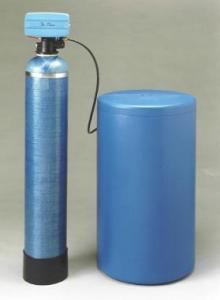Hayward Water Softeners Installation
 If you are like 90% of the homeowners in the United States, a water softener system can help you improve your home water quality. There are several indications that you may be dealing with a hard water problem in your home. If your dishes constantly have spots on them after they've gone through the dishwasher or your shower curtain is covered in a residue after your shower, you probably have hard water. If your clothes come out of the washer without that bright luster they had before they went in or if there is a yellowish tinge to your tap water it is likely that you have magnesium, calcium and even iron in your water supply. Our Hayward plumbing team can help you diagnose a hard water problem and then fix it with a water softener installation.
If you are like 90% of the homeowners in the United States, a water softener system can help you improve your home water quality. There are several indications that you may be dealing with a hard water problem in your home. If your dishes constantly have spots on them after they've gone through the dishwasher or your shower curtain is covered in a residue after your shower, you probably have hard water. If your clothes come out of the washer without that bright luster they had before they went in or if there is a yellowish tinge to your tap water it is likely that you have magnesium, calcium and even iron in your water supply. Our Hayward plumbing team can help you diagnose a hard water problem and then fix it with a water softener installation.
Water picks up minerals while it is in underground aquafirs. Calcium and magnesium are just a few of the many minerals dissolved in the water that gets pumped to your home but they are the two that cause the bulk of the problems in your home plumbing system. This is because they prevent soap from being fully dissolved in the water. Instead of dissolving, some of the soap congeals with these tow minerals and becomes a curd-like substance. This curd does not dissolve in water and clings to clothing, dishes and even your skin. This is the source of the soap scum that leaves that slimy covering on your bathtub, shower curtain and inside of the dishwasher.
Get Your Water Softener Installed Today
 While all of these problems are a pain, they aren't the worst part of hard water. These build ups also occur on the interior of your pipes. This can end up causing a reduced area from water to flow through. This increases the pressure inside the pipes which can cause weak joints to leak and even cause full blockages in the pipe system. Even worse, these minerals can build up inside of water heaters and cause electric heating elements to fail. This can cause your water heater to fail years before it's time.
While all of these problems are a pain, they aren't the worst part of hard water. These build ups also occur on the interior of your pipes. This can end up causing a reduced area from water to flow through. This increases the pressure inside the pipes which can cause weak joints to leak and even cause full blockages in the pipe system. Even worse, these minerals can build up inside of water heaters and cause electric heating elements to fail. This can cause your water heater to fail years before it's time.
All of these reasons are why most homes should be equipped with a water softener. The water softener uses a chemical replacement system that removes the calcium and magnesium from the water and replaces it with sodium. Here's how it works.
You Can Count On Our Hayward Plumbers
A water softener has two tanks, a brine tank and a softener tank. The softener tank is filled with negatively charged plastic beads that draw the positively charged calcium and magnesium away from the water. The water is then pumped into the brine tank where it is combined with water softener salt. The sodium from the softener salt dissolves in the water taking the place of the magnesium and calcium. The water is then pumped back out into the home system. Because sodium has none of the ill effects of the removed minerals, all of the side effects of hard water will diminish.
For more information on water softeners, contact our Hayward plumbers today!